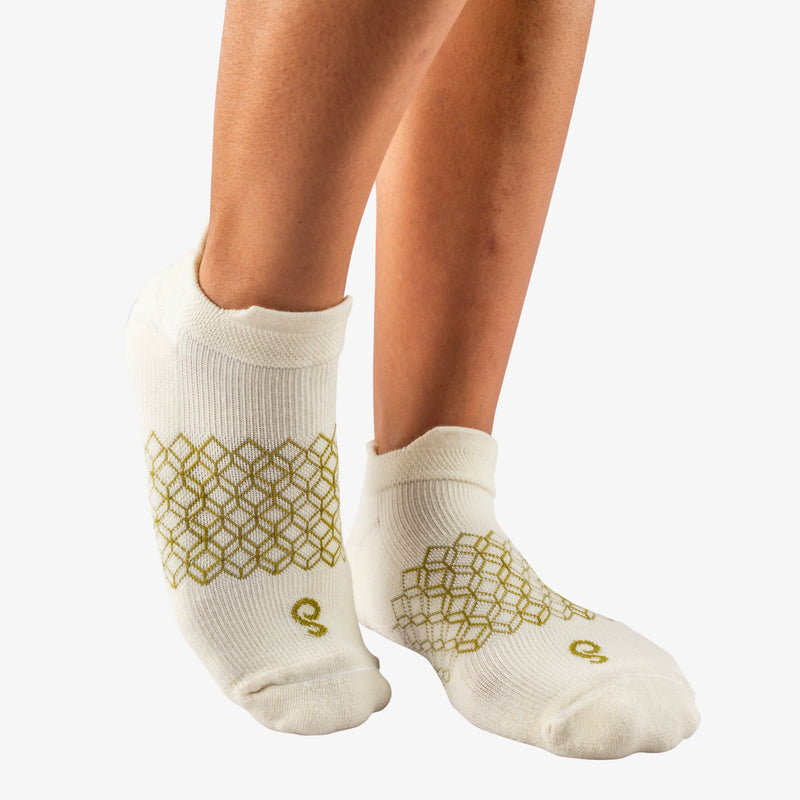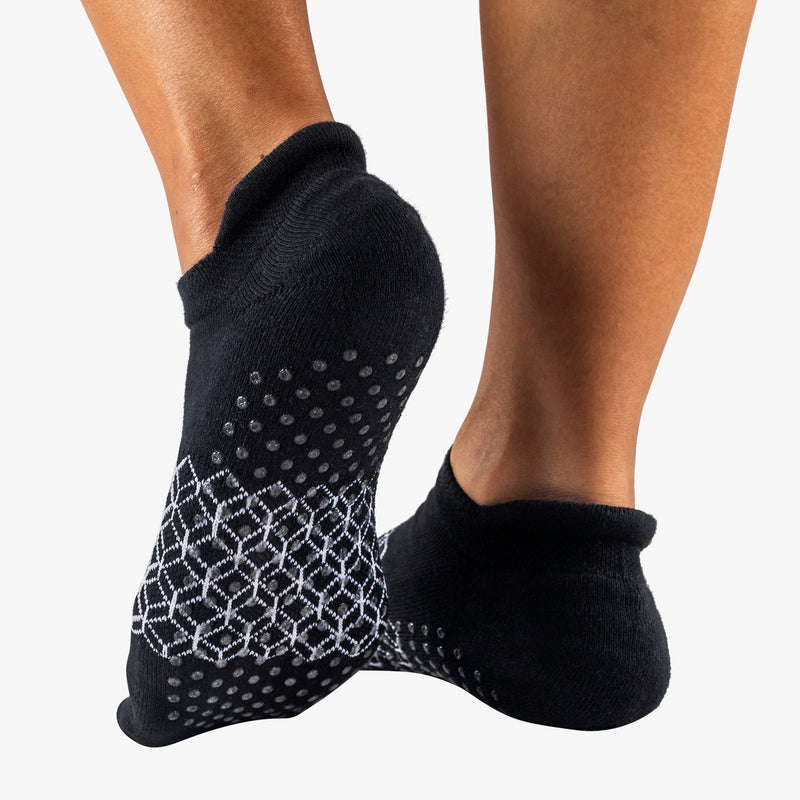
Yoga socks are designed to enhance stability and grip during practice, making them a popular choice among yoga enthusiasts in the UK. These socks typically feature non-slip soles that help prevent slipping on mats, allowing for better balance and control. This is especially beneficial during challenging poses or for those who practise in colder environments where slipping can be a concern.
The variety of styles and materials available can cater to personal preferences and specific needs. Whether one prefers toe-free designs for a barefoot feel or full coverage for warmth, there are options to suit all practitioners. Many yoga socks are also made from breathable materials, ensuring comfort through extended sessions.
In addition to functionality, yoga socks can add a touch of style to the routine. With numerous colours and patterns available, they not only serve a practical purpose but also allow individuals to express their personality while practising. The right pair of yoga socks can enhance both performance and enjoyment of the practice.
Benefits of Yoga Socks in the UK
Yoga socks offer several advantages that can enhance a person’s practice.
Improved Grip
Many yoga socks feature rubberised soles that provide better traction on slippery surfaces. This is particularly beneficial in studios with polished floors or during hot yoga sessions.
Warmth and Comfort
Yoga socks keep the feet warm, aiding flexibility. This is especially useful in colder months when participants may feel discomfort on chilly floors.
Safety
Wearing socks can reduce the risk of slipping, which can lead to injuries. This added safety element can help practitioners focus more on their poses and less on their stability.
Hygiene
In shared yoga spaces, socks can enhance hygiene. They create a barrier between the feet and communal surfaces, reducing exposure to germs.
Style Variety
Yoga socks come in various designs and colours, allowing individuals to express personal style. This variety can make the yoga experience more enjoyable.
For those in the UK, these benefits make yoga socks a practical investment for both beginners and seasoned practitioners.
Key Features to Look for in Yoga Socks
When selecting yoga socks, it is crucial to consider certain features that enhance performance and comfort.
Grip: Look for socks with silicone or rubber grips on the soles. This provides traction and prevents slipping during poses.
Material: Choose breathable fabrics like cotton or a blend that allows moisture-wicking. This keeps feet dry and comfortable throughout the session.
Fit: A snug fit is essential. Socks should not be too tight or too loose, allowing for movement without restricting circulation.
Toe Design: Some yoga socks have individual toe compartments, enhancing flexibility and grip. Others are designed with a closed toe for added warmth.
Height: Consider the height of the socks. Ankle socks provide less coverage, while crew-length socks offer more warmth and may prevent the ankles from getting cold.
Cushioning: Some models feature extra cushioning in the soles. This can provide added comfort for longer practices, especially on hard floors.
Washability: Yoga socks should be easy to wash. Look for machine-washable options that maintain their shape and grip after multiple washes.
By focusing on these key features, individuals can enhance their yoga experience and improve their practice.
Popular Brands of Yoga Socks in the UK
Several brands offer high-quality yoga socks designed to enhance grip and comfort during practice. Among the top choices are ToeSox, Gaiam, Sweaty Betty, and hipSwan. Each brand brings unique features and benefits to cater to various preferences.
ToeSox
ToeSox are renowned for their unique five-toe design. This feature allows for natural toe splaying, enhancing stability during yoga poses. Many users appreciate the added grip provided by silicone dots on the sole, which helps prevent slippage on different surfaces.
The materials used are often a blend of cotton and spandex, ensuring a snug fit that maintains breathability. ToeSox come in various styles, including those with and without straps, appealing to both minimalist and more supportive preferences. Their commitment to eco-friendly production processes also resonates well with environmentally conscious yogis.
Gaiam
Gaiam is a well-established name in the fitness industry, offering an array of yoga accessories, including yoga socks. Their socks are designed with a combination of comfort and functionality. Gaiam's models typically feature textured soles for enhanced traction and are made from soft, moisture-wicking fabric.
This helps keep feet dry and comfortable during workouts. Many Gaiam socks also have arch support, which adds stability and comfort during practice. The brand frequently releases new colours and patterns, allowing enthusiasts to express their personal style while practicing yoga.
Sweaty Betty
Sweaty Betty caters to a fashionable audience seeking both style and performance. Their yoga socks are crafted with a focus on aesthetics without compromising functionality. Made from breathable materials, they provide comfort and moisture management during intense sessions.
Sweaty Betty socks often feature non-slip grips on the soles, ensuring stability on mats or studio floors. With a range of trendy designs, these socks allow wearers to incorporate their personal flair into their yoga attire. The brand's individual focus on women's fitness also significantly influences their product offerings, making them a popular choice among female yogis in the UK.
hipSwan
A relative newcomer to the yoga socks market, hipSwan is a UK based brand and their "Flow" gripper socks for yoga is a leader in the category. Their socks are distinguished by premium organic combed cotton, luxurious cushioning, a compression arch band for a contoured fit, and internal heel grips. They are available in 3 sizes to fit a broad range of men and women.
The hipSwan brand is aligned with "conscious consumers" who prioritise sustainability. In addition to having a traceable supply chain, minimal/recycled packaging, and focussing on natural yarns like GOTS-certified organic cotton and merino wool, they are carbon neutral and plant one tree for every online order.
Material Considerations for Yoga Socks
When selecting yoga socks, the material plays a crucial role in performance and comfort. The most common materials include:
-
Cotton: Soft and breathable, cotton offers good moisture absorption. It’s suitable for moderate practice but may not provide the grip needed in more vigorous sessions.
-
Polyester: Known for its durability and moisture-wicking properties, polyester keeps feet dry. This material is ideal for those who sweat more during workouts.
-
Nylon: Often blended with other materials, nylon adds strength and elasticity. It helps the socks maintain their shape and provides a snug fit.
-
Bamboo: This sustainable option is naturally antibacterial and highly absorbent. Bamboo socks are soft against the skin and offer excellent ventilation.
-
Spandex: Typically used in combination with other fibres, spandex adds stretch. It allows for better movement and flexibility.
When choosing yoga socks, consider the thickness as well.
-
Thin socks offer more sensitivity and connection to the mat.
-
Thicker options provide additional cushioning but might reduce tactile feedback.
The choice of material and thickness affects grip, comfort, and overall satisfaction during practice. Each material has its advantages, catering to different preferences and yoga styles.
Different Types of Yoga Socks
Yoga socks are designed to enhance grip, provide comfort, and improve balance during practice. Each type serves specific needs and preferences, catering to various styles of yoga.
Grip Socks
Grip socks are a popular choice among yogis. They feature rubberised soles with textured patterns that provide increased traction on yoga mats. This design helps prevent slipping during poses, particularly in more dynamic classes like vinyasa or power yoga.
These socks often come with elasticised cuffs that keep them securely in place. Made from breathable materials, they offer comfort while allowing for flexibility. Many brands offer a variety of designs and colours, making it easier for individuals to express their personal style while practising.
Toeless Socks
Toeless socks are designed to provide the benefits of grips while allowing for natural toe movement. This type of sock features an open toe design, which helps maintain contact with the mat for enhanced balance and grounding.
They are particularly beneficial in styles that require significant foot flexibility, such as Ashtanga. The toeless design gives yogis a sense of freedom while still enjoying the traction of grip technology. Often made with lightweight materials, these socks keep feet feeling cool and comfortable throughout the practice.
Full-Toe Socks
Full-toe socks cover the entire foot, offering warmth and comfort. Unlike toeless variants, they provide coverage to the toes and help keep feet insulated during practice in cooler environments.
These socks typically include individual toe pockets, resembling a glove for the feet. This feature promotes better grip and stability, as each toe can move independently. Full-toe socks are ideal for restorative yoga sessions or when practicing on colder surfaces. They come in various styles and thicknesses, catering to the preferences of different practitioners.
Sizing and Fit Guidance for Yoga Socks
Choosing the right size for yoga socks is crucial for optimal performance. A proper fit ensures comfort and stability during practice.
Yoga socks typically come in various sizes. Most brands offer the following size options:
| Size | UK Shoe Size |
|---|---|
| Small | 3-5 |
| Medium | 6-8 |
| Large | 9-11 |
To find the best fit, consider these factors:
- Foot Width: Feet can vary in width, so choose a size that accommodates this aspect comfortably.
- Material Stretch: Many yoga socks are made from stretchy materials, allowing for a snug fit.
- Length of Use: If the user plans to wear the socks for extended periods, a slightly looser fit might be more comfortable.
When trying on yoga socks, ensure they allow for movement without slipping. They should provide grip on the soles while hugging the foot well.
Different brands may have specific sizing charts, so checking these before purchase is recommended. It can prevent discomfort and enhance performance.
Finally, consider trying socks on with the type of yoga mat intended for use. This provides a better sense of grip and stability.
Caring for Your Yoga Socks
Maintaining the quality of yoga socks is essential for their longevity. Proper care ensures they remain effective and comfortable during yoga practice.
Washing Instructions:
- Gentle Cycle: Wash yoga socks on a gentle cycle to prevent wear.
- Cold Water: Use cold water to help retain the fabric’s elasticity.
- Mild Detergent: Opt for a mild detergent to avoid harsh chemicals.
Drying Tips:
- Air Dry: It is best to air dry yoga socks to prevent shrinking or damage from heat.
- Avoid Direct Sunlight: Keeping them out of direct sunlight helps prevent colour fading.
Storage Recommendations:
- Cool, Dry Place: Store yoga socks in a cool, dry area to avoid moisture build-up.
- Avoid Folding: Roll socks instead of folding to maintain shape and prevent creasing.
Regular Inspections:
- Check for signs of wear, such as thinning fabric or holes.
- Promptly retire any damaged socks to maintain safety during practice.
By following these care tips, yoga socks can maintain their grip and support throughout many sessions.
Where to Buy Yoga Socks in the UK
Finding the right yoga socks is essential for comfort and stability during practice. There are various places to shop, including online retailers and physical stores, each providing distinct advantages.
Online Retailers
Online shopping provides access to a wide variety of yoga socks from different brands. Websites like Amazon and eBay offer numerous options, often with customer reviews for guidance. Specialty sites such as YogaOutlet and Onzie also focus on yoga-related products.
Prices can vary significantly. Discounts and promotions are frequently available, making it easier to find affordable choices. Furthermore, online retailers often feature size guides to assist in selecting the right fit.
Delivery options are typically flexible, with many retailers offering free UK delivery for orders over a certain amount. Returns are generally straightforward, allowing buyers to exchange socks that do not meet their expectations.
Physical Stores
Shopping in physical stores allows for a hands-on approach. Retailers like Decathlon and John Lewis carry yoga socks, enabling customers to try different styles and sizes before purchasing. Local yoga studios often sell branded socks, providing options that may not be found elsewhere.
High street sports shops, such as Sports Direct, also stock various brands. This in-person experience can be beneficial for those who prefer to assess the quality and fit directly.
Some retail stores may offer promotions or exclusive styles not available online. Engaging with staff can provide insights into the best socks for one's specific yoga practice.
Price Range and Quality Comparison
Yoga socks in the UK are available across a broad price spectrum. Typically, prices range from £5 to £30.
Factors such as material, design, and brand significantly impact the cost.
| Price Range | Quality Indicators |
|---|---|
| £5 - £10 | Basic materials, minimal grip, basic designs |
| £11 - £20 | Moderate quality, good grip, various designs |
| £21 - £30 | High-quality materials, excellent grip, diverse features |
Lower-priced yoga socks may use simpler fabrics like cotton blends, offering basic support.
Mid-range options generally feature a mix of cotton and synthetic fibres, providing better durability and comfort.
Premium socks focus on advanced materials such as silicone grips and moisture-wicking properties. Brands in this range often prioritise performance and unique design features.
Customers should consider their budget alongside the intended use. Regular practitioners might invest in higher-quality options for increased comfort and safety.
In contrast, beginners can opt for more affordable options to determine their needs before committing to pricier items.
Environmental Considerations of Yoga Socks
Yoga socks can have varying environmental impacts based on their materials and manufacturing processes.
Materials:
- Cotton: Often considered a sustainable choice, especially if organic.
- Bamboo: Biodegradable and requires less water to grow.
- Synthetic Blends: May contribute to microplastic pollution during washing.
Production:
Manufacturing processes can vary significantly. Eco-friendly brands often prioritise sustainable practices, such as:
- Reduced water usage
- Non-toxic dyes
- Ethical labour practices
Packaging:
Sustainable packaging options are increasingly becoming a focus. Brands might use:
- Recyclable materials
- Minimalist designs to reduce waste
End of Life:
The disposal of yoga socks should be considered. Options include:
- Recycling, if applicable
- Composting biodegradable materials
- Donating gently used socks
When choosing yoga socks, consumers can research brands focused on sustainability. This can reduce their overall ecological footprint and promote responsible consumption in the yoga community.
Conclusion
Yoga socks play a valuable role in enhancing grip and stability during practice. Many individuals in the UK prefer them for this reason. They can help prevent slips, especially on smooth studio floors.
When selecting yoga socks, one should consider factors such as:
- Material: Look for breathable and moisture-wicking fabrics.
- Design: Non-slip soles are essential for safety.
- Fit: Ensure they provide a snug yet comfortable fit.
Ultimately, incorporating yoga socks into practice can significantly enhance one's yoga experience. They not only improve performance but also add a layer of safety and comfort.












